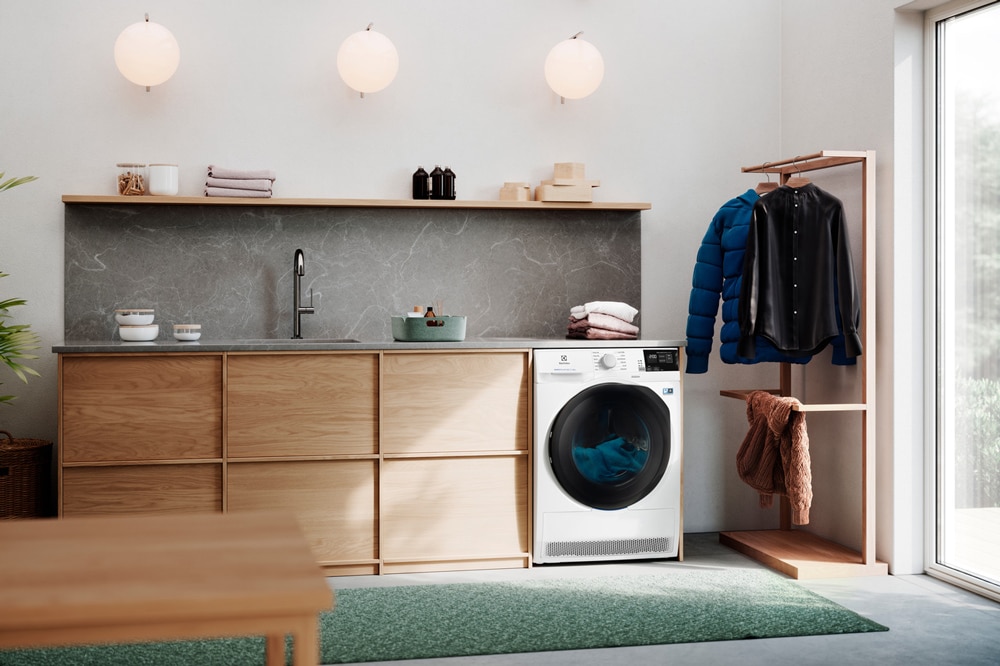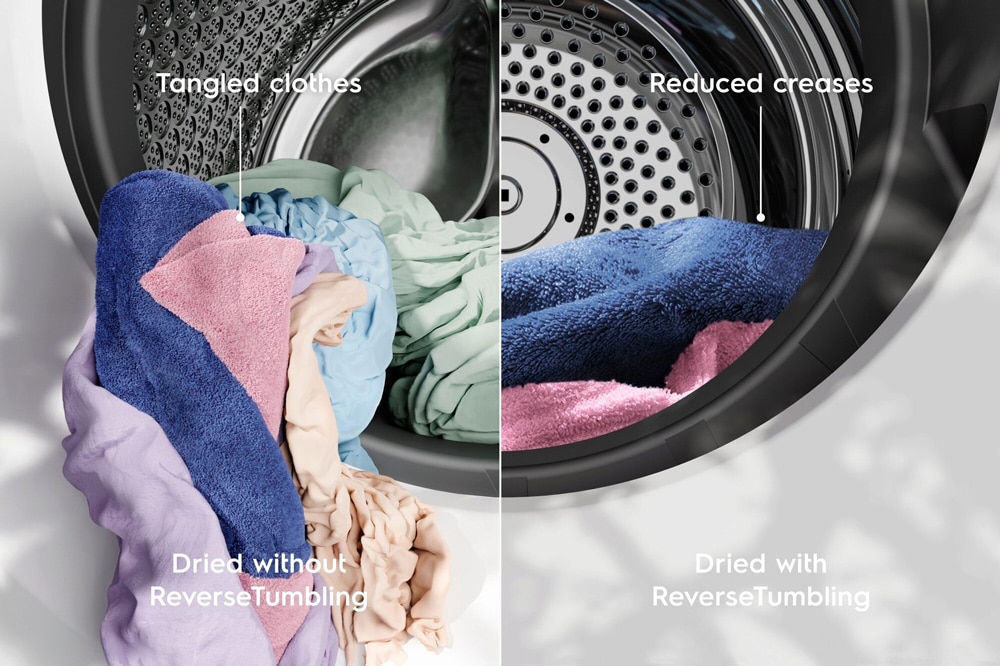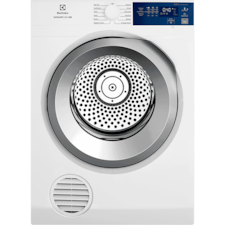A dryer is an essential appliance for modern households, offering convenience and efficiency in handling laundry. With so many options available, choosing the right dryer can feel overwhelming. This guide will help you navigate the key factors to consider when buying a clothes dryer to meet your needs and lifestyle.
There are a few questions you should ask yourself to find the best clothes dryer:
- How many types of dryers are there in the market?
- How many people are going to use those dryers, or to put it in another way, which dryer capacity should you consider?
- Which type of dryer is the most affordable in terms of the product price and operational costs?
- What features does the desired dryer model possess?
Types of dryers
When buying a dryer, the first decision you will need to make is choosing the right type for your home. Here are different types of clothes dryers available:
Venting dryer
For large households that go through multiple loads every day or minimalist-driven capsule wardrobe owners, laundry can be stressful when you’re reliant on unpredictable weather conditions. Venting dryers are your best choice as they are an economical option to achieve the fastest drying speed and turnaround time for multiple loads, so you can wash heavy laundry loads and store them right away with minimal fuss. However, you need to install a ducting hose to vent out the hot and damp air from the dryer if it is placed in an enclosed room like kitchen or storeroom.
Check out three of our latest Electrolux venting dryer models below:
- ReverseTumbling reduces wrinkles up to 1/3*.
- Sensors adjust cycles to reduce wear and tear.
- ColourCare reduces fading by up to 80%*.
- ReverseTumbling reduces wrinkles up to 1/3*.
- Sensors adjust cycles to reduce wear and tear.
- ColourCare reduces fading by up to 80%*.
Condenser dryer
Condenser dryers are a versatile option that doesn’t require external venting. Instead of expelling moisture outside, these dryers extract moisture from clothes and store it in a removable water tank or drain it through a hose. This design makes condenser dryers easy to install in any space with a power outlet. They are especially useful in apartments or homes without access to exterior walls. However, they tend to consume slightly more energy than vented models. Despite this, the convenience of not needing a vent makes them a popular choice for modern households seeking flexibility.
Heat pump dryer
Heat pump dryers are the most energy-efficient dryers on the market, using advanced technology to recycle hot air and reduce energy consumption. Instead of venting air or storing moisture in a tank, these dryers use a heat pump to extract moisture and release dry air back into the drum for continued drying. Heat pump dryers are gentle on clothes, preserving fabric quality over time, which makes them ideal for delicate garments. While they have a higher upfront cost, the energy savings in the long run can offset the initial investment. Heat pump dryers are perfect for environmentally conscious households looking to reduce their energy consumption without compromising performance.
Clothes dryer dimensions and capacity
How big or small a dryer should you get depends on how many people are going to use that dryer, your laundry needs, and the space you have for it.
Dryer capacity: How much do you need?
Dryers are also measured in capacity to suit different household sizes. Here’s a guide to choosing the right dryer size based on your laundry needs:
|
Dryer capacity |
Household size |
How many clothes |
|
5-6kg dryers |
1-2 people |
Around 5 outfits or 5 towels per load |
|
6-8kg dryers |
3-4 people |
5-7 outfits or 5-7 towels per load |
|
8+ kg dryers |
4+ people |
8+ outfits or 8+ towels per load |
Dryer dimensions: How to measure for a perfect fit

When choosing a dryer, it’s essential to ensure it fits seamlessly into your laundry area while allowing adequate space for ventilation. Here's a step-by-step guide on measuring for a dryer and optimizing your laundry space for a hassle-free setup.
1. Measure your laundry space
Start by measuring the available space where you plan to place your dryer. Take note of the following dimensions to ensure the dryer will fit comfortably:
- Width: Measure from side to side to determine how wide your dryer can be. Standard dryer widths are 60cm. Make sure to leave 2-5 cm of clearance on each side for proper airflow.
- Height: Measure from the floor to the ceiling or any overhead cabinets or shelves. Standard dryers are around 85cm height. If you’re stacking a dryer on top of a front-load washing machine, check that there’s enough vertical clearance for both appliances.
- Depth: Measure from the wall to the front edge of the space. Dryer depths range from 55cm to 75cm, depending on the model and capacity. Leave at least 10cm of space behind the dryer for ventilation hoses or drainage connections.
If your laundry space is limited, consider a washer dryer combo as an efficient alternative. Washer dryers combine washing and drying functions in one appliance, saving both space and time. They’re an ideal solution for compact homes or apartments where separate machines may not fit.
2. Ventilation requirements
Different types of dryers have varying ventilation requirements.
- Venting dryer: Requires an external vent to expel hot, damp air. Ensure there’s a nearby exterior wall or window to install a ducting hose.
- Condenser dryer: Requires space to accommodate a water tank or drainage hose. It can be placed in enclosed spaces without external venting.
- Heat pump dryer: Requires minimal ventilation and can be installed in tighter spaces due to its energy-efficient design.
Tip: If you plan to install a venting dryer, ensure the vent hose isn’t bent, as this can reduce drying efficiency.
3. Check power and water connections
Before purchasing a dryer, verify that your laundry space has the correct power outlet and, if needed, a water connection for certain models.
By following these guidelines, you will ensure your dryer fits perfectly into your space, operates efficiently, and keeps your laundry routine smooth and stress-free.
Energy efficiency ratings
When choosing a clothes dryer, energy efficiency plays a crucial role in reducing both electricity consumption and long-term utility costs.
One of the key indicators of a dryer’s energy efficiency is the Energy Star rating. Dryers with an Energy Star label use at least 20% less energy than non-certified models. By choosing an Energy Star-rated dryer, you’re opting for a product that not only dries your clothes effectively but also helps conserve resources, making it an eco-friendly choice for your home.
For optimal energy savings, consider investing in a heat pump dryer, which operates using advanced energy-saving technology. These models use up to 50% less energy than venting dryers or condenser dryers, helping to reduce your electricity bills while keeping your laundry routine eco-friendly.
What features to look for when buying a clothes dryer
When purchasing a dryer, it’s essential to consider features that enhance convenience, protect your clothes, and reduce energy consumption. Here are some key features for you to consider:
Sensor drying
A dryer with sensor drying technology ensures your clothes are not over-dried, preventing damage and saving energy. By automatically stopping the cycle when moisture levels are low, this feature helps reduce wear and tear on fabrics.
Reverse tumbling

Reverse Tumbling is a game-changer for preventing wrinkles and tangling. Electrolux dryers alternate the drum’s rotation during the drying process, keeping clothes evenly distributed and reducing the need for ironing. This feature is particularly helpful for larger loads, ensuring that every item dries thoroughly and comes out looking fresh.
Quick dry options
For those times when you need a quick turnaround, Electrolux dryers offer a 30-minute timed drying cycle that can handle small loads efficiently. This quick-dry function is perfect for drying everyday fabrics that need to be dried quickly, helping you save time and energy.
Delicate program
A delicate program is essential for safeguarding fabrics that require extra care, such as silk, wool, and lace. Electrolux dryers with DelicateCare feature ensure that these sensitive garments are dried with precise control to maintain their shape, texture, and softness.
Related reading: Items you should (and shouldn't) put in the dryer
Conclusion
A clothes dryer is a valuable investment for any household, making laundry tasks more manageable and efficient. By understanding the different types of dryers, their features, and energy efficiency ratings, you can choose the perfect dryer to fit your home and lifestyle.
For reliable insights, explore Electrolux India’s dryer reviews featuring real-life experiences. These customer testimonials showcase how our dryers perform in everyday settings, helping you choose a model that meets your laundry needs with confidence.
Dryer FAQs
-
How much electricity does a clothes dryer use?
A clothes dryer typically uses 1.8 to 5.0 kWh per cycle, depending on the model, capacity, and drying program. Opting for Energy Star-rated dryer can further reduce energy consumption and save on utility bills.
-
How long does it take for a dryer to dry clothes?
Drying time depends on the dryer type, load size, and fabric type. On average, it takes 30 to 90 minutes to dry a full load. Some dryers, like Electrolux models with a 30-minute quick cycle, can dry smaller loads faster, making them convenient for busy households.
-
How long does a dryer last?
A well-maintained dryer can last 10 to 15 years on average. Regular cleaning of the lint filter, ensuring proper ventilation, and scheduling occasional servicing can help extend its lifespan. Investing in a quality dryer with durable components can also improve longevity.


